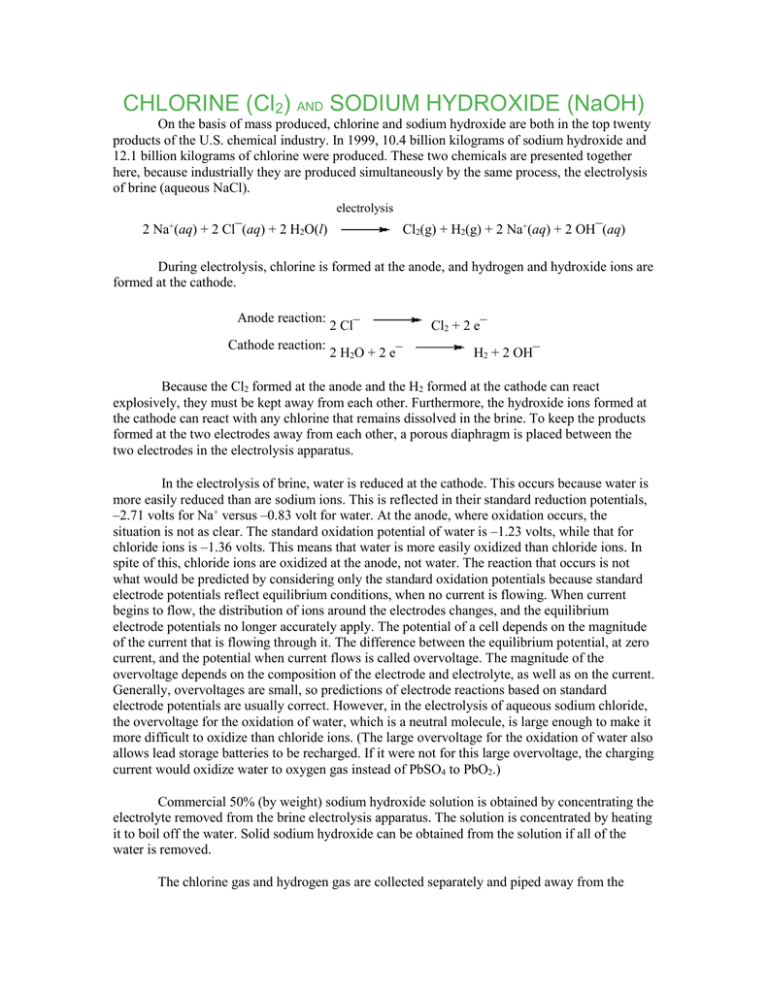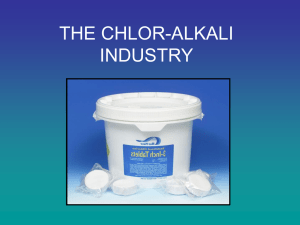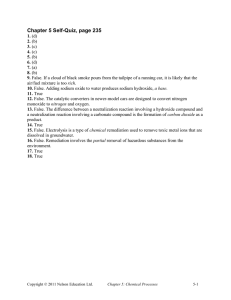CHLORINE (Cl ) SODIUM HYDROXIDE (NaOH) 2
advertisement

CHLORINE (Cl2) AND SODIUM HYDROXIDE (NaOH) On the basis of mass produced, chlorine and sodium hydroxide are both in the top twenty products of the U.S. chemical industry. In 1999, 10.4 billion kilograms of sodium hydroxide and 12.1 billion kilograms of chlorine were produced. These two chemicals are presented together here, because industrially they are produced simultaneously by the same process, the electrolysis of brine (aqueous NaCl). electrolysis + Cl2(g) + H2(g) + 2 Na+(aq) + 2 OH¯(aq) 2 Na (aq) + 2 Cl¯(aq) + 2 H2O(l) During electrolysis, chlorine is formed at the anode, and hydrogen and hydroxide ions are formed at the cathode. Anode reaction: Cathode reaction: 2 Cl¯ 2 H2O + 2 e¯ Cl2 + 2 e¯ H2 + 2 OH¯ Because the Cl2 formed at the anode and the H2 formed at the cathode can react explosively, they must be kept away from each other. Furthermore, the hydroxide ions formed at the cathode can react with any chlorine that remains dissolved in the brine. To keep the products formed at the two electrodes away from each other, a porous diaphragm is placed between the two electrodes in the electrolysis apparatus. In the electrolysis of brine, water is reduced at the cathode. This occurs because water is more easily reduced than are sodium ions. This is reflected in their standard reduction potentials, –2.71 volts for Na+ versus –0.83 volt for water. At the anode, where oxidation occurs, the situation is not as clear. The standard oxidation potential of water is –1.23 volts, while that for chloride ions is –1.36 volts. This means that water is more easily oxidized than chloride ions. In spite of this, chloride ions are oxidized at the anode, not water. The reaction that occurs is not what would be predicted by considering only the standard oxidation potentials because standard electrode potentials reflect equilibrium conditions, when no current is flowing. When current begins to flow, the distribution of ions around the electrodes changes, and the equilibrium electrode potentials no longer accurately apply. The potential of a cell depends on the magnitude of the current that is flowing through it. The difference between the equilibrium potential, at zero current, and the potential when current flows is called overvoltage. The magnitude of the overvoltage depends on the composition of the electrode and electrolyte, as well as on the current. Generally, overvoltages are small, so predictions of electrode reactions based on standard electrode potentials are usually correct. However, in the electrolysis of aqueous sodium chloride, the overvoltage for the oxidation of water, which is a neutral molecule, is large enough to make it more difficult to oxidize than chloride ions. (The large overvoltage for the oxidation of water also allows lead storage batteries to be recharged. If it were not for this large overvoltage, the charging current would oxidize water to oxygen gas instead of PbSO4 to PbO2.) Commercial 50% (by weight) sodium hydroxide solution is obtained by concentrating the electrolyte removed from the brine electrolysis apparatus. The solution is concentrated by heating it to boil off the water. Solid sodium hydroxide can be obtained from the solution if all of the water is removed. The chlorine gas and hydrogen gas are collected separately and piped away from the electrolysis apparatus. The chlorine is dried, compressed, and liquefied for shipping and storage. Although the hydrogen can be compressed and stored in cylinders, the commercial value of hydrogen in not sufficient to warrant this. The hydrogen is usually burned at the electrolysis plant to provide the thermal energy used to evaporate water from the sodium hydroxide solution. At room temperature, chlorine is a yellow-green gas. It condenses to a liquid at -34°C and freezes to a solid at -101°C. It has a piercing, irritating odor, and is caustic to mucous membranes such as the eyes and lungs. Chlorine is moderately soluble in water, and a saturated aqueous solution contains 0.062 M Cl2, 0.030 M hypochlorous acid (HOCl), and 0.030 M chloride ions. Cl2(aq) HOCl(aq) + H+(aq) + Cl-(aq) Treating this solution with a hydroxide, such as NaOH or Ca(OH)2, produces a solution containing the hypochlorite ion. Cl2(aq) + 2 OH¯(aq) OCl¯(aq) + Cl¯(aq) + H2O(l) Sodium hypochlorite is the active ingredient of "chlorine" laundry bleach, and calcium hypochlorite is used as a disinfectant in swimming pools. About 20% of the chlorine produced industrially is used in the manufacture of chlorinated plastics (mainly polyvinyl chloride). Another 15% is used in the production of solvents (such as carbon tetrachloride), 5% in the manufacture of paper, 5% in water treatment, and the remainder in the production of a variety of other chemicals. Gaseous chlorine reacts with hydrocarbons to form chlorinated hydrocarbons. Chlorine will replace the hydrogen atoms in methane, CH4, sequentially producing chloromethane, CH3Cl, methylene chloride, CH2C12, chloroform, CHC13, and carbon tetrachloride, CH4. The last three of these products are important solvents in the chemical industry. Another important chlorinated hydrocarbon is vinyl chloride, CH2=CHCl. About 10 billion pounds of this substance are manufactured each year, to be turned into polyvinyl chloride, CH2CHCln. Polyvinyl chloride is used extensively for piping and plumbing, raincoats, shower curtains, magnetic tape, flooring, and electrical wire insulation. Chlorine reacts (explosively, under certain conditions) with hydrogen to produce hydrogen chloride, HCl. Cl2(g) + H2(g) 2 HCl(g) Hydrogen chloride is extremely soluble in water, forming a solution called hydrochloric acid. A saturated solution at 25°C is 12 M in HCl. When it dissolves in water, HCl ionizes completely, forming H+ and Cl- ions. Sodium hydroxide is a white solid with a melting point of 3l8°C. It is very soluble in water. A saturated solution is 18 M in NaOH at 20°C. Solutions of sodium hydroxide are very corrosive to the skin and other organic matter. Hence, its name in commerce is caustic soda. The major industrial uses of sodium hydroxide are in the manufacture of chemicals (60%), in the paper industry (20%), in the production of aluminum (5%), and in the manufacture of soaps and detergents (5%). The paper industry uses the caustic effects of sodium hydroxide on organic materials. Sodium hydroxide breaks down the lignin in wood. Lignin is a binder that holds cellulose fibers together in wood. When the lignin is removed, the freed cellulose fibers can be formed into paper. The digestive effects of sodium hydroxide on organic materials is the principle behind such drain cleaners as Liquid Plumr, which is a concentrated aqueous solution of sodium hydroxide. Sodium hydroxide hydrolyzes the ester linkage in fats and oils to produce glycerol (HOCH2-CHOH-CH2OH) and sodium salts of carboxylic acids containing long chains of carbon atoms (e.g., stearic acid, CH3(CH2)16COOH). These salts are soaps. Similar salts of synthetic acids containing long chains of carbon atoms are called detergents.




